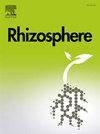Host selection shapes structure and network of microbial community of Epimedium plants along the soil–rhizosphere–plant continuum
IF 3.4
3区 生物学
Q1 PLANT SCIENCES
引用次数: 0
Abstract
Background and aims
Microbiota inhabiting plants are essential for plant productivity and health. Microbes in various plant compartment niches perform distinct ecological functions. However, the microbial characteristics in different niches of Epimedium plants, one of the most promising tonic herbs in traditional Chinese medicine, remain largely unknown.
Methods
Here, microbial composition, diversity and co-occurrence network in the five ecological niches (bulk soil, rhizosphere soil, root, stem, and leaf) of three Epimedium plant cultivars were investigated using high-throughput sequencing.
Results
The microbial composition were predominately imprinted by compartment niches than by host cultivars. Bacterial diversity and network complexity incrementally decreased from the soils to the root to the leaf; however, fungal diversity and network complexity gradually decreased from the soils to the root to the stem but increased from the stem to the leaf. Cyanobacteria, Proteobacteria, Arthrobacter, Sphingomonas, and Gemmatimonas were bacterial keystone taxa, while Ascomycota, Davidiella, and Hymenoscyphus were fungal keystone taxa. These taxa exhibited significant compartment-specific properties and performed distinct ecological functions.
Conclusion
The microbial communities are mostly originated from bulk soil, and subsequently filtered and enriched in various compartment niches through host selection. Compartment niches profoundly imprinted the plant-associated microbiota, which provided valuable insights into harnessing beneficial communities for Epimedium plants in sustainable agriculture and the improvement of herbal quality.
求助全文
约1分钟内获得全文
求助全文
来源期刊

Rhizosphere
Agricultural and Biological Sciences-Agronomy and Crop Science
CiteScore
5.70
自引率
8.10%
发文量
155
审稿时长
29 days
期刊介绍:
Rhizosphere aims to advance the frontier of our understanding of plant-soil interactions. Rhizosphere is a multidisciplinary journal that publishes research on the interactions between plant roots, soil organisms, nutrients, and water. Except carbon fixation by photosynthesis, plants obtain all other elements primarily from soil through roots.
We are beginning to understand how communications at the rhizosphere, with soil organisms and other plant species, affect root exudates and nutrient uptake. This rapidly evolving subject utilizes molecular biology and genomic tools, food web or community structure manipulations, high performance liquid chromatography, isotopic analysis, diverse spectroscopic analytics, tomography and other microscopy, complex statistical and modeling tools.
 求助内容:
求助内容: 应助结果提醒方式:
应助结果提醒方式:


